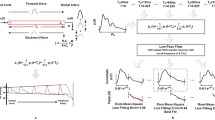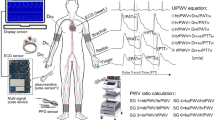Abstract
Generalized transfer functions (GTFs) are available to compute the more relevant proximal blood pressure (BP) waveform from a more easily measured peripheral BP waveform. However, GTFs are based on the black box model. This paper presents a practical approach to reconstruct brachial artery pressure (BAP) distally from finger artery pressure (FAP). We assume that continuous BAP can be simply approximated by summing two halves of the continuous FAP shifted by the time delay. We firstly showed that the pressure wave in the finger artery can be considered twice as much as the forward/backward wave in the finger. A simplified individualized transfer function was then derived so as to estimate BAP from FAP. The effectiveness of the method was examined by experiment involving 26 healthy volunteers (26.7 ± 3.8 years old) in a resting state. By comparing with a reference BAP, we found that the proposed method can correct the FAP. The errors of the proposed method in estimating systolic and diastolic pressures are − 0.6 ± 6.0 and − 0.6 ± 3.7 mmHg, respectively. These results agree with the standard of Association for the Advancement of Medical Instrumentation (AAMI). We also found that the reconstructed BAP from FAP by terminal arterial occlusion technology (TAOT) is comparable to that of the artery occlusion technology (AOT). Our method or TAOT is promising in estimating continuous proximal blood pressure from peripheral blood pressure in practice.







Similar content being viewed by others
References
Kroeker E, Wood E (1955) Comparison of simultaneously recorded central and peripheral arterial pressure pulses during rest, exercise, and tilted position in man. Circ Res 3(6):623–632
Thore C-J, Stalhand J, Karlsson M (2008) Toward a non-invasive subject specific estimation of abdominal aortic pressure. Am J Physiol 295(3):1156–1164
Hahn J-O, Reisner AT, Asada HH (2009) Blind identification of two-channel IIR systems with application to central cardiovascular monitoring. ASME J Dyn Syst Meas Control 131(5):051009
Swamy G, Ling Q, Li T, Mukkamala R (2007) Blind identification of the aortic pressure waveform from multiple peripheral artery pressure waveforms. Am J Physiol 292(5):2257–2264
Stergiopulos N, Westerhof BE, Westerhof N (1998) Physical basis of pressure transfer periphery to aorta: a model-based study. Am J Physiol 274(4):H1386–H1392
Ghasemi Z, Kim CS, Ginsberg E, Gupta A, Hahn J-O (2017) Model-based blind system identification approach to estimation of central aortic blood pressure waveform from non-invasive diametric circulatory signals. ASME J Dyn Syst Meas Control 139(6):061003
Sugimachi M, Shishido T, Miyatake K, Sunagawa K (2001) A new model-based method of reconstructing central aortic pressure from peripheral arterial pressure. Jpn J Physiol 51(2):217–222
Swamy G, Olivier NB, Mukkamala R (2010) Calculation of forward and backward arterial waves by analysis of two pressure waveforms. IEEE Trans Biomed Eng 57(12):2833–2839
Hahn J-O, Reisner AT, Jaffer FA, Asada HH (2012) Subject-specific estimation of central aortic blood pressure using an individualized transfer function: a preliminary feasibility study. IEEE Trans Inf Technol Biomed 16(2):212–220
Gao M, Cheng HM, Sung SH, Chen CH, Olivier NB, Mukkamala R (2016) Estimation of pulse transit time as a function of blood pressure using a nonlinear arterial tube-load model. IEEE Trans Biomed Eng 64(7):1524–1534
Chung E, Chen G, Alexander B, Cannesson M (2013) Non-invasive continuous blood pressure monitoring: a review of current applications. Front Med 7(1):91–101
Newman DL, Greenwald SE, Bowden NL (1979) An in vivo study of the total occlusion method for the analysis of forward and backward pressure waves. Cardiovasc Res 13:595–600
Rubinstein EH, Sessler DI (1990) Skin-surface temperature gradients correlate with finger blood flow in humans. Anesthesiology 73(3):541–545
Stergiopulos N, Westerhof BE, Westerhof N (1998) Physical basis of pressure transfer from periphery to aorta: a model-based study. Am J Physiol 274(4):H1386–H1392
Forouzanfar M, Ahmad S, Batkin I, Dajani HR, Groza VZ, Bolic M (2013) Coefficient-free blood pressure estimation based on pulse transit time-cuff pressure dependence. IEEE Trans Biomed Eng 60(7):1814–1824
Teng XF, Zhang YT (2007) Theoretical study on the effect of sensor contact force on pulse transit time. IEEE Trans Biomed Eng 54(8):1490–1498
Payne RA, Symeonides CN, Webb DJ, Maxwell SR (2006) Pulse transit time measured from the ecg: an unreliable marker of beat-to-beat blood pressure. J Appl Physiol 100(1):136
Mukkamala R, Hahn J-O, Inan OT, Mestha LK (2015) Toward ubiquitous blood pressure monitoring via pulse transit time: theory and practice. IEEE Trans Biomed Eng 62(8):1879–1901
Fazeli N, Kim CS, Rashedi M, Chappell A, Wang S, Macarthur R, McMurtry MS, Finegan B, Hahn J-O (2014) Subject-specific estimation of central aortic blood pressure via system identification: preliminary in-human experimental study. Med Biol Eng Comput 52(10):895–904
Bos WJ, Van GJ, van Montfrans GA, Ah VDM, Wesseling KH (1996) Reconstruction of brachial artery pressure from noninvasive finger pressure measurements. Circulation 94(8):1870–1875
Gao M, Rose WC, Fetics B, Kass DA, Chen CH, Mukkamala R (2016) A simple adaptive transfer function for deriving the central blood pressure waveform from a radial blood pressure waveform. Sci Rep 6:33230
Swamy G, Xu D, Olivier NB, Mukkamala R (2009) An aFAPtive transfer function for deriving the aortic pressure waveform from a peripheral artery pressure waveform. Am J Physiol 297(5):H1956–H1963
Zhang PD, Qiu QL, Luo Y, Zhou YX, Liu J (2017) A simple method for reconstruction of continuous brachial artery pressure from continuous digital artery pressure in humans. Engineering in Medicine and Biology Society (EMBC), 39th Annual International Conference of the IEEE, pp 1696–1699
Sugimachi M, Shishido T, Miyatake K, Sunagawa K (2001) A new model-based method of reconstructing central aortic pressure from peripheral arterial pressure. Jpn J Physiol 51(2):217
Wong KKL, Tu JY, Sun Z, Dissanayake DW (2013) Methods in research and development of biomedical devices. World Scientific Publishing Co, Singapore, ISBN: 978-981-4434-99-7
Tu JY, Wong KKL, Cheung SCP, Beare R, Phan T (2011) Analysis of patient-specific carotid bifurcation models using computational fluid dynamics. J Med Imaging Health Inform 1(2):1–10
Funding
This study was funded by the Shenzhen Science and Technology Innovation Commission (Grant No. KQCX2015033117354152).
Author information
Authors and Affiliations
Corresponding author
Ethics declarations
Conflict of interest
Author Pandeng Zhang has received research grants from the institutional review board of Shenzhen Institutes of Advanced Technology (SIAT), Chinese Academy of Sciences (CAS).
Ethical approval
All procedures performed in studies involving human participants were in accordance with the ethical standards of the institutional and/or national research committee and with the 1964 Helsinki declaration and its later amendments or comparable ethical standards.
Informed consent
Informed consent was obtained from all individual participants included in the study.
Rights and permissions
About this article
Cite this article
Zhang, P., Qiu, Q. & Zhou, Y. Reconstruction of continuous brachial artery pressure wave from continuous finger arterial pressure in humans. Australas Phys Eng Sci Med 41, 1115–1125 (2018). https://doi.org/10.1007/s13246-018-0652-9
Received:
Accepted:
Published:
Issue Date:
DOI: https://doi.org/10.1007/s13246-018-0652-9




